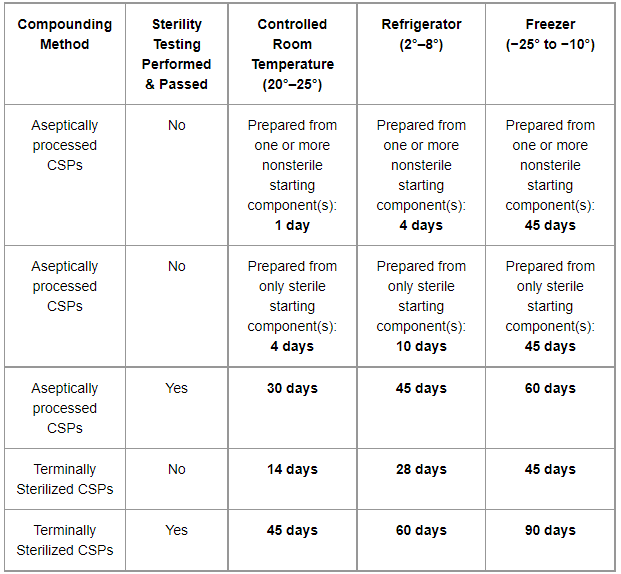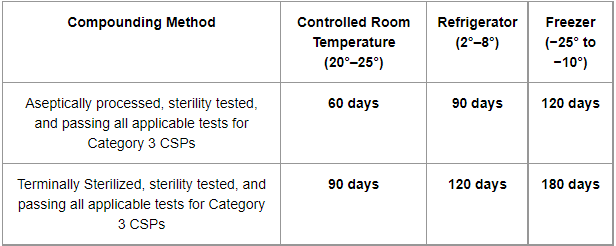The USP <797> BUD limits are based on the risk of microbial contamination or not achieving and maintaining sterility. The CSP formulation must remain chemically and physically stable, and its packaging must maintain its integrity for the duration of the BUD. A shorter BUD must be assigned when the stability of the CSP or its components is less than the hours or days stated in the applicable tables below. Additionally, the BUD must not exceed the shortest remaining expiration date or BUD of any of the starting components.
Beyond Use Dating Stability Factors:
- Chemical and physical stability properties of the drug and/or its formulation
- Compatibility of the container closure system with the finished preparation (e.g., leachables, interactions, adsorption, and storage conditions)
Beyond Use Dating Sterility Factors:
- Conditions of the environment in which the CSP is prepared (Cleanroom suite or SCA)
- Aseptic processing and sterilization method
- Starting components (Sterile or nonsterile starting ingredients)
- Whether or not sterility testing is performed
- Storage conditions (Packaging and temperature)
Category 1 CSP Longest Permitted Beyond Use Dates

Category 2 CSP Longest Permitted Beyond Use Dates

Multiple-Dose CSPs must be prepared as a Category 2 or Category 3 CSP.
Preserved CSPs
- BUD is assigned according to Category 2 or Category 3
- Must pass testing per USP <51>
- After container is entered or punctured, must not be used for longer than assigned BUD or 28 days if supported by USP <51>, whichever is shorter.
Nonpreserved CSPs (aqueous ophthalmic)
- BUD is assigned according to Category 2 or Category 3
- Must pass testing per USP <51>
- USP <51> is not required only if the CSP is for use by a single patient and the container label includes the following statement "Discard 24 hours after first opening when stored at controlled room temperature or after 72 hours when stored under refrigeration."
Stability Data Requirements for Category 3 CSPs:
The BUD assigned to a Category 3 CSP must be supported by stability data obtained using a stability indicating analytical method that is able to distinguish the active ingredient from its degradants and impurities (e.g., by forced degradation studies) and quantify the amount of the active ingredient.
- The Category 3 CSP must be prepared according to the exact formulation (API and other ingredients of identical grade and procedures) from which the stability data are derived.
- The Category 3 CSP must be packaged and stored in a container closure of the same materials of composition as that used in the study.
- The analytical method must be validated based on characteristics such as those described in <1225> Validation of Compendial Procedures.
- The compounding facility must have documentation of the stability study, including a description of the methodology (e.g., number of samples taken, storage conditions), validation of the method, the stability-indicating analytical method, and all of the results of the study.
If the Category 3 CSP is an injection (<788> Particulate Matter in Injections) or if it is an ophthalmic solution (<789> Particulate Matter in Ophthalmic Solutions), particulate-matter testing is conducted once per formulation with acceptable results.
Once for each formulation and for each container closure system in which it will be packaged, the container closure system used is evaluated for and conforms to container closure integrity (see <1207> Package Integrity Evaluation—Sterile Products).
Category 3 CSP Longest Permitted Beyond Use Dates

